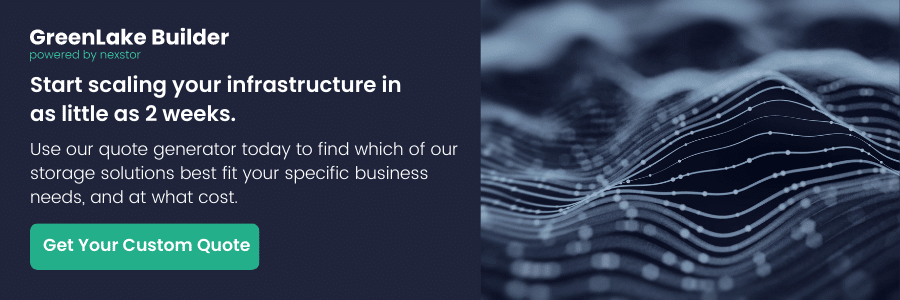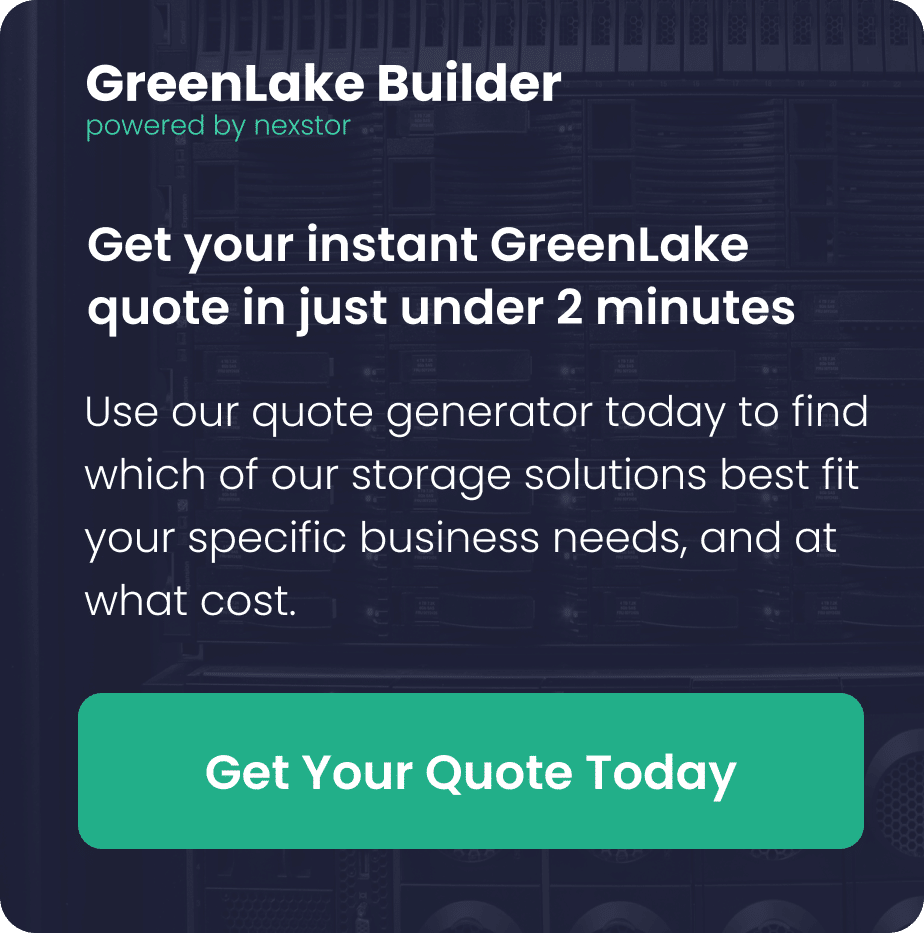Which Solution is Right for Your Business?
Data storage, backup and management are some of the biggest challenges facing IT teams today.
Not only do companies need to store sizable amounts of data, but they also need to prioritise security and keep costs on an even keel.
These requirements have put the public cloud at the centre of innovation for the last decade, and, according to a recent Gartner report, global spending on the public cloud is expected to increase to $599 billion in 2023 alone.1 This is dominated by spending on three key areas:
- Cloud Application Infrastructure Services (PaaS): $136,404mn expected spend in 2023.
- Cloud System Infrastructure Services (IaaS): $156,276mn expected spend in 2023.
- Cloud Application Services (SaaS): $208,080mn expected spend in 2023.2
While the public cloud is popular, it’s not perfect. 31% of companies report being worried about how secure their sensitive data is in public storage, concerned about the overall lack of visibility and increasingly unpredictable costs. 3
HPE GreenLake aims to eliminate these problems through an innovative hybrid cloud model.
In this article, we’ll outline the main differences between GreenLake and the public cloud, and demonstrate the key differences GreenLake aims to solve.

The public cloud: does it need to change?
Over the last decade, the public has transformed IT operations by allowing businesses to easily scale and grow without worrying about excessive hardware costs or limitations.
But with cloud vulnerabilities increasing year-on-year, many IT teams are turning to alternative solutions. In 2023, 73% of businesses named the hybrid cloud as their preferred strategy, while only 13% chose the public cloud.4
Let’s consider some of the key benefits and problems with the public cloud:
The key benefits
- A high level of scalability: Providing businesses with the space they need to rapidly grow and expand IT resources.
- Easy accessibility: Cloud-based data storage can help to drive efficiency by ensuring all members of a team have access to the necessary data and information.
- A centralised location: Data can all be accessed in one place, by multiple different people at once.
- A high level of network reliability: Most public clouds are reliable and secure, potentially reducing the unpredictability often seen in hardware.
The key problems
- Hybrid systems: Not all data can go on the public cloud. This leaves information siloed between VPCs, the public cloud, and on-premises solutions, complicating data management processes and increasing security weak spots.
- Security: 57% of respondents to Nexstor’s disaster recovery survey cited security as their primary worry for disaster recovery to the cloud. Although there are many ways to make the public cloud secure, it has a reputation for poor security and data breaches.
- Expense: Whether due to unforeseen egress fees or the need for over-provisioning, the public cloud can rack up expenses, fast.
As Joe Pemberton, HPE Cloud and Data Partner Lead, commented:
‘There will be applications that are right for the cloud, and there will be applications and workloads which will have to stay on-premise for reasons of security or transportability. We saw a long time ago that the hybrid cloud would be where most people end up — and that seems to have panned out.’5
By recognising the current challenges with the cloud, we start to get insight into why HPE GreenLake is so beneficial.
What is HPE GreenLake?
Although HPE GreenLake can’t be viewed as a direct opposition to the public cloud, it aims to tackle many of these challenges through an innovative, hybrid cloud model.
HPE GreenLake is a platform that allows IT leaders to easily purchase, manage and view their data from a single pane of glass. From it, you can procure almost any HPE solution, from cloud backup to primary storage.
It helps to unify data from across the public cloud, private cloud, on-prem and hybrid systems by connecting them all through a single console.
Since being launched, HPE GreenLake has continually evolved alongside user needs. At its core, one key goal has remained the same: to remove the need for over-provisioning by allowing IT departments to only consume, secure and pay for the infrastructure they need.
The public cloud vs HPE GreenLake: a head-to-head comparison
1. Security
SaaS apps and cloud-based storage are reported to be the biggest targets for cyber attacks in 2023.6 The reasons for this are several —
- They provide poor visibility, especially as data quantities grow.
- Multi-user access can increase the risk of leaks.
- The misconfiguration of cloud controls, such as unsecured AWS S3, excessive permissions, and default credentials, can increase data exposure.
Some of these issues are inherent in the structure of the public cloud while others are dependent on how it is configured.
Pro tip: The public cloud can still enable high levels of security with the help of partners like Nexstor, who can integrate security solutions such as Arctic Wolf and ensure all backup data is held in line with the highest security standards.
HPE GreenLake’s ‘secure by design approach’ means that it evades many of the security concerns that typically come with the cloud. GreenLake has HPE Integrated Lights-Out, protecting hardware at the silicon level, while HPE Zerto DRaaS delivers ‘always on’ replication to ensure data is fully protected.
The GreenLake central management portal also provides visibility across a number of different IT infrastructures, ensuring that team leaders are aware of any security risks before breaches occur.
2. Costs
Data requirements are continually pushing IT budgets to the limit. HPE GreenLake’s locked-term pricing packages are costed according to a monthly unit of measure selected by the user, ensuring that spending can stay in check. And, as Joe Pemberton recognises,
‘From a power and cooling cost perspective as well, this kind of pricing structure is perfect. […] Savings in energy and cooling have always been a good thing, but with the costs now as they are, it’s a huge benefit to be able to reduce that bill for power and cooling.’7
The cost of the public cloud will, of course, vary widely depending on the provider. But in 2022, CEO of the tech market analysis firm Canalys shared that they expected public cloud costs to grow by 30% in 2023 alone — driven up by energy costs, inflation and a chip shortage.8
As well as this organic price growth in the tech market, public cloud costs can be high due to:
- Overprovisioning: This means businesses have to continually pay for capacity they aren’t using.
- Scalability: This benefit of the public cloud is also a downside, which some providers take advantage of. If you choose to use the public cloud, be careful that your provider doesn’t charge excessively for rapid scaling.
- Egress fees: If you need to restore your data, you may be hit by egress fees.
In this particular point, HPE GreenLake is a clear winner. It has the scalability of the cloud while being much more cost-secure, allowing businesses to grow their capacity as and when needed.
3. Scalability
Scalability has always been the cloud’s strongest selling point, especially in comparison to more limited on-prem solutions.
Countless companies will over-provision to overcome these setbacks. But as data sets grow and big data challenges become the norm, over-provisioning is no longer a cost-effective choice.
- Traditional on-prem: You have to over-provision to start with, and may have too greatmuch or too little capacity. This either means you are limited or are paying excess for capacity you don’t need. You might only reassess capacity once every 3-5 years, and it can take a long time to add new servers or devices.
- Public cloud solutions: You can scale easily, depending on which vendor you use, but costs will be high. If you need to suddenly access data in backup storage, for example, you may be charged large amounts for egress.
HPE GreenLake allows users to scale according to a ‘pay-as-you-grow’ model. Other than a basic minimum commit, you can scale according to your needs. HPE CEO Antoni Neri comments:
‘I actually would argue it [HPE GreenLake] is even better than the public cloud, because when you go to the public cloud you tend to overprovision resources. In our case, we actually can scale that resource exactly to the need of that application and meter that and charge for that.’9
HPE’s commitment to monitoring GreenLake users’ IT infrastructure means that capacity is always available when required, and can be easily controlled through a central platform.
Both the public cloud and HPE GreenLake are highly scalable. If you don’t expect to grow rapidly and are unlikely to need to restore cold data, the public cloud might be a good option for you.
But if you are growing fast and need an easily adaptable solution, HPE Greenlake is likely to be the better choice.
4. Control
89% of companies now take a multi-cloud approach, so a high level of control in IT operations is essential.10
HPE GreenLake helps companies keep control over their networks by providing a unified console for complex hybrid cloud environments. The GreenLake management platform allows you to:
- Monitor and adjust your capacity.
- Configure user access based on roles.
- Purchase new services and infrastructure.
The public cloud can be integrated with some management solutions and platforms, but in itself it can be hard to maintain control over data — especially when outsourcing data storage. Inevitably, there will be some things that you’ll want to keep on-prem, and these might get lost in the process of moving to the cloud.
Which solution is right for you will in depend in large part on the size of your operations, your existing cloud infrastructure, and your business goals. When choosing your cloud solution, try considering the following questions:
- Do you need to keep the majority of your data on-prem?
- Are you expecting your business to grow fast?
- Is your data highly sensitive?
If you answered ‘yes’ to most of the above, then GreenLake’s high levels of control and interconnected hybrid cloud will likely be the best fit. If you answered ‘no’, then it’s possible the public cloud could still work for you with the help of the right provider.
Pro tip: Read our article, ‘Public vs Private vs Hybrid Clouds: Your Guide to Cloud Storage’, to learn about the benefits of different cloud solutions.
Finding a solution that fits your needs
The key difference between HPE GreenLake and the public cloud is data management.
GreenLake provides a comprehensive data management platform from which companies can far more easily determine what their data’s doing, which users have access, and how to scale data storage most effectively for spending and usage. The public cloud alone is reasonably easy to manage but could become siloed when used as part of a hybrid network.
Whether you want a new storage solution or are looking for ways to improve the security of your data, Nexstor’s bespoke managed IT services can help.
We’re a trusted HPE partner and work with a wide range of vendors to help you find the perfect solution for your requirements. We offer 24/7 support and maintenance to ensure your data is secure.
If you think HPE GreenLake might be the right solution for you, try our quote calculator to discover which specific services and products meet your needs.
1 55 Cloud Computing Statistics That Will Blow Your Mind (2023)
2 Gartner Forecasts Worldwide Public Cloud End-User Spending to Reach Nearly $500 Billion in 2022
3 5 challenges to public cloud security
4 Enterprise cloud strategy worldwide 2023 | Statista
5 Why Choose HPE GreenLake? – Nexstor
7 Why Choose HPE GreenLake? – Nexstor
8 Public Cloud Costs to Rise “at least 30%” in 2023 Warns Analyst Firm | hSo
9 HPE CEO Antoni Neri on GreenLake’s lowest cost per-workload advantage
Share:

